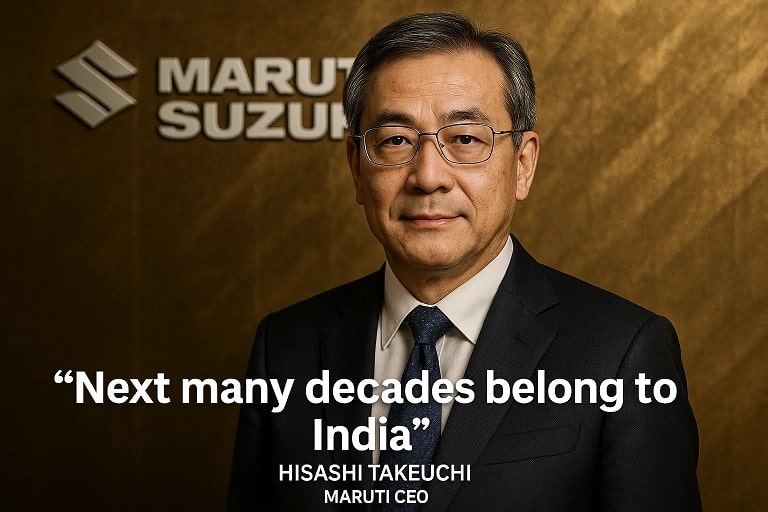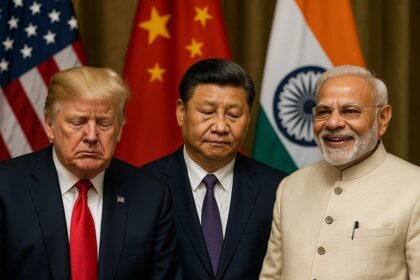Maruti CEO Declares ‘Next Many Decades Belong to India’ Amid Global Manufacturing Push
In a bold statement at the 65th Automotive Component Manufacturers Association (ACMA) Annual Convention on September 12, 2025, Maruti Suzuki India’s Managing Director and CEO, Hisashi Takeuchi, proclaimed that “the next many decades belong to India” as a global economic powerhouse. Highlighting India’s potential to become the world’s manufacturing hub, Takeuchi emphasized the importance of policy stability and leveraging the country’s demographic and economic strengths. This declaration, echoing optimism about India’s industrial future, has sparked widespread discussions about the nation’s role in the global automotive and manufacturing sectors. This comprehensive article delves into the context of Takeuchi’s remarks, recent developments, historical parallels, economic impacts, future prospects, and more, providing a holistic view of India’s trajectory as a manufacturing leader.
Why Takeuchi’s Statement Resonates Globally
Takeuchi’s assertion comes at a pivotal moment when global supply chains are shifting away from China, which dominated as the “factory of the world” for the past three decades. With India boasting the world’s largest working-age population and a rapidly growing economy projected to hit $4.1 trillion by 2026, the Maruti CEO’s vision aligns with India’s ambition to capture a larger share of global manufacturing. His emphasis on policy continuity—citing initiatives like Make in India and production-linked incentives (PLI)—underscores the need for a stable environment to attract investment and foster growth.
Key Highlights of Takeuchi’s Speech
- Global Economic Shift: Takeuchi noted that China’s era as the manufacturing hub is waning, with India poised to take the lead.
- Demographic Advantage: India’s 600-million-strong working-age population is a key driver for industrial growth.
- Policy Stability: Consistent government policies are critical for India to become a global manufacturing hub.
- Automotive Sector Leadership: Maruti Suzuki aims to drive India’s export growth, targeting markets in Africa, Latin America, and Southeast Asia.
Latest Events and Developments
ACMA Convention 2025: A Platform for Optimism
On September 12, 2025, the ACMA convention in New Delhi served as the stage for Takeuchi’s remarks, attended by over 500 industry leaders, policymakers, and global stakeholders. The event focused on positioning India as a leader in the global automobile supply chain, with discussions on US tariffs, local component manufacturing, and sustainability. Takeuchi’s speech was a highlight, reinforcing Maruti Suzuki’s commitment to expanding production and exports.
Maruti Suzuki’s Strategic Moves in 2025
Maruti Suzuki announced plans to increase its production capacity by 500,000 units annually by 2027, with a new plant in Gujarat set to commence operations in early 2026. The company also signed agreements with local suppliers at the ACMA event to boost indigenous component manufacturing, aligning with the government’s Atmanirbhar Bharat (Self-Reliant India) initiative. These moves are expected to create 10,000 direct jobs and bolster India’s automotive export market, valued at $20 billion in FY25.
Policy Support and Government Response
The Indian government, through Commerce Minister Piyush Goyal, echoed Takeuchi’s optimism on September 12, 2025, announcing enhanced PLI schemes for auto components, targeting $10 billion in investments by 2030. This aligns with India’s goal to double its manufacturing GDP contribution to 20% by 2030, reinforcing the CEO’s vision of a decades-long economic ascent.
Historical Context: India’s Manufacturing Journey
India’s manufacturing ambitions have deep roots, tracing back to the post-independence era when industrial policies prioritized self-sufficiency. The establishment of Maruti Udyog Limited in 1981, in collaboration with Japan’s Suzuki Motor Corporation, marked a turning point for India’s automotive sector, transforming it from a niche industry to a global player. The “Make in India” initiative launched in 2014 further catalyzed growth, attracting foreign direct investment (FDI) of over $100 billion in manufacturing by 2025.
Timeline of India’s Manufacturing Milestones
Year | Event | Impact |
|---|---|---|
| 1981 | Maruti Udyog Founded | Introduced affordable cars, spurring automotive growth. |
| 2014 | Make in India Launched | Attracted global manufacturers, boosting FDI. |
| 2020 | PLI Scheme Introduced | Incentivized local production in auto, electronics, and more. |
| 2025 | Maruti CEO’s Speech | Signals India’s rise as a global manufacturing hub. |
Historically, China’s manufacturing dominance from the 1990s to 2020s relied on low costs and scale. India’s emergence as a viable alternative leverages its demographic dividend, improving infrastructure, and investor-friendly reforms, positioning it to capture opportunities in a post-China global economy.
Economic and Social Impacts of India’s Manufacturing Push
Job Creation and Economic Growth
Takeuchi’s vision aligns with projections that India’s manufacturing sector could create 50 million jobs by 2035, driven by automotive and allied industries. Maruti Suzuki alone employs over 40,000 workers and supports 1.6 million indirect jobs through its supply chain. The sector’s growth is expected to contribute $1 trillion to India’s GDP by 2030, reducing reliance on services-led growth.
Global Supply Chain Integration
India’s rise as a manufacturing hub could reshape global supply chains, with companies like Apple, Tesla, and now Maruti Suzuki expanding local production. Exports of auto components, valued at $8 billion in 2025, are projected to double by 2028, strengthening India’s trade balance and reducing dependence on imports.
Challenges and Risks
Despite optimism, challenges remain, including infrastructure bottlenecks, skill gaps, and global trade tensions, such as recent US tariffs on Indian exports. Ensuring policy stability, as Takeuchi emphasized, will be critical to sustaining investor confidence amid geopolitical uncertainties.
Future Scopes: India’s Path to Manufacturing Dominance
Long-Term Manufacturing Leadership
By 2040, India could capture 10% of global manufacturing output, up from 3% in 2025, driven by sectors like automotive, electronics, and pharmaceuticals. Maruti Suzuki’s plans to export 750,000 vehicles annually by 2030 signal a robust push into markets like Japan, Europe, and Africa.
Technological Advancements and Sustainability
Maruti Suzuki is investing $2 billion in electric vehicle (EV) production and hybrid technologies, aiming for 50% of its portfolio to be electric by 2030. This aligns with India’s net-zero goals and positions the country as a leader in sustainable manufacturing.
Policy and Infrastructure Development
The government’s $100 billion infrastructure push, including freight corridors and industrial parks, will enhance India’s manufacturing competitiveness. Continued reforms in labor laws and tax policies could attract an additional $50 billion in FDI by 2030.
Potential Scenarios for 2030
- Optimistic Outlook: India becomes the second-largest manufacturing hub after China, with automotive exports hitting $50 billion.
- Moderate Growth: Steady progress with 7% annual manufacturing growth, tempered by global economic slowdowns.
- Pessimistic Scenario: Trade barriers and domestic challenges limit growth to 5%, delaying India’s global ascent.
Frequently Asked Questions (FAQs)
What did Maruti Suzuki’s CEO mean by “next many decades belong to India”?
Hisashi Takeuchi highlighted India’s potential to lead global manufacturing, driven by its young workforce and stable policies, succeeding China’s three-decade dominance.
Why is India poised to become a manufacturing hub?
India’s large working-age population, improving infrastructure, and investor-friendly policies like PLI schemes make it attractive for global manufacturers.
How is Maruti Suzuki contributing to India’s growth?
The company is expanding production, boosting exports, and investing in EVs, creating jobs and strengthening local supply chains.
What role does policy stability play in India’s manufacturing ambitions?
Consistent policies ensure investor confidence, enabling long-term commitments from global firms like Maruti Suzuki.
What challenges could hinder India’s manufacturing rise?
Infrastructure gaps, skill shortages, and global trade tensions, like US tariffs, pose risks to sustained growth.
How will India’s automotive sector benefit from this vision?
Increased production, exports, and EV adoption could position India as a global automotive leader by 2030.
India’s Manufacturing Moment: A Global Opportunity
Hisashi Takeuchi’s declaration at the ACMA convention encapsulates India’s ambition to redefine its economic destiny. As Maruti Suzuki leads the charge in automotive innovation, India stands at the cusp of a manufacturing revolution, poised to shape global markets for decades. With strategic policies and industry leadership, the nation is ready to claim its place as the world’s next economic powerhouse.
Key Takeaways
- Global Shift: India is set to succeed China as a manufacturing leader, per Takeuchi’s vision.
- Economic Impact: Job creation and export growth to drive $1 trillion GDP contribution.
- Maruti’s Role: Expanding capacity and EV focus to bolster India’s global presence.
- Policy Imperative: Stability is key to sustaining investor trust and growth.












